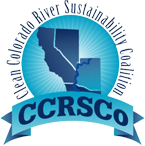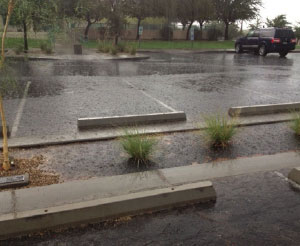
-
Clean Colorado Sustainability Coalition
2330 McCulloch Blvd. N.
Lake Havasu City, AZ 86403
Phone: (928)453-4152
contact
Success Stories
Reduction of Groundwater Nitrate Concentrations via Expansion and Upgrades of Centralized Wastewater Collection Systems
As noted in the Threats Section, elevated nitrate-nitrogen levels (above 10mg/L) in groundwater adjacent to the Colorado River pose a potential health problem in drinking water supplies. One probable nitrate source recognized is the septic tank, of which tens of thousands have existed in both urban and rural settings in the region. In an effort to reduce nitrate levels in underlying aquifers, a series of projects took place from the late 1990's through at least 2017 to improve and greatly expand centralized sewage collection and treatment. These efforts have reduced nitrate concentrations in treated wastewater that is either disposed into underlying aquifers or directly into the Colorado River or is reused for irrigation. These projects include:
City of Needles:
In 1999 Needles waste water collection system was extended to a community within the city referred to as "Gates". This extension allowed approximately 98 homes to eliminate their septic tanks and attach to the collection system. In 2001 a new waste water treatment plant was put into operation replacing the 1950's treatment plant. The new SBR style plant greatly improved the effluent being produced by the waste water treatment plant and also eliminated effluent from being piped directly into the Colorado River. In 2003 the Needles Bazoobuth lift station was completely redesigned / rebuilt, increasing capacity and reliability and reducing the potential for sewer spills. In 2015 over 1600 feet of new sewer line was installed in the California Ave. area to replace collapsed and leaking sewer line under Interstate 40. In 2016 the old waste water effluent pipe was removed. This was a 12" diameter by 50 feet long steel pipe with a significant support structure protruding out into the river and causing a serious boating hazard. The pipe and all of its columns were removed. In 2017, due to the addition of almost 200 new homes along the river in the Rio Buena Vista community, the Needles, River Rd lift station was redesigned and rebuilt increasing capacity and reliability.
City of Bullhead City:
Bullhead City spent more than $154 million from 1999 to 2008 expanding their centralized collection and treatment system by adding 125 miles of pipe and eliminated >9,000 septic tanks. The City's existing wastewater collection and treatment systems consist of two WWTP, 15 lift stations, and approximately 7 miles of force mains and 253 miles of gravity sewers that range in size from 6-inch to 42-inch in diameter. The collection system conveys wastewater flows into either the Section 10 or Section 18 WWTP by a combination of gravity pipes and force mains within the collection system. The Section 18 and Section 10 WWTPs have capacities of 2 and 4 million gallons per day (mgd), respectively. The Section 18 WWTP receives flow from the northernmost drainage basin, while the Section 10 WWTP receives flow from the southernmost drainage basin. The middle drainage basin can pump flow to either WWTP via the Sierra (16-2) Lift Station. Wastewater in the collection system generally flows from east to west, towards the Colorado River. As the topography becomes flatter approaching the Colorado River, a series of force mains are used to transfer wastewater to one of the WWTPs as previously described. One of the goals expressed by City staff is to investigate the possibility of reducing the number of lift stations along the Colorado River and replacing them with gravity pipes, wherever feasible.
Lake Havasu City:
Lake Havasu City spent more than $350 million expanding their centralized collection and treatment system from 2002 to 2011, which eliminated >22,000 septic tanks and constructed the 3.5 MGD gallon North Regional wastewater treatment plant (expandable to 12 MGD) with advanced membrane filtration to help handle the increased wastewater flows. This work added more than 300 miles of gravity sewer lines, 25 miles of force mains, and 49 pump stations that are connected to all three wastewater treatment plants for flexible sewage treatment situations. An 18" effluent line system also connects all three wastewater treatment plants and current/future reuse sites. This work also afforded the opportunity to increase the water use efficiency within the city. Older PVC water service lines to each residence with new sewer service were replaced with more resilient wrapped copper lines during sewer installation to prevent potable water leakage. The increased treated wastewater flows gives the city the ability to expand its water reuse program and diminishing Colorado River water demands.
Chemehuevi Tribe:
Sewer system upgrades in the Havasu Landing area include the gravity line system (2003-2004), lift station #2 and #3 in 2005, its 12-inch force main from residential to primary lift station and fully replaced force from finale lift station to sewer ponds (2006), the resort lift station (2008), and to the casino and HUD residential lift station (2012/2013). The wastewater lagoon was re-located and lined and 5 lift stations for gravity feed system have also been upgraded.
The Buckskin Sanitary District:
Occurring on the Parker Strip along the Colorado River north of Parker, Arizona, in 1997 the District installed the Phase 1 wastewater collection system and acquired the Buckskin Wastewater Treatment Plant (WWTP). In 2007, the District began implementing the installation of the Phase 2 and Phase 3 wastewater collection system. These phases were completed in 2010. Sewage collection and treatment improvements for Phase 4 occurred from 2012 to 2017, which included construction of sanitary sewer facilities along Riverside Drive from Patria Flats County Park to Sundance Resort to serve all of the properties within Buckskin Sanitary District (with the exception of the undeveloped state land parcels) along both sides of Riverside Drive. The District began preparations for Phases 5 and 6 in 2013 and developed preliminary sewage collection design work for these phases from 2014-2016.
City of Yuma:
Yuma has spent over $20 million expanding their sewage collection and treatment system with new development.
Hexavalent Chromium — Topock
As mentioned in the Threats section, hexavalent chromium present in soils and groundwater in California adjacent to the Colorado River has been under intense investigation and is now entering a long-term remediation phase (30+years). Chromium will be immobilized and much groundwater has been and will continue to be extracted, treated and properly disposed. Details are provided at the following website: dtsc-topock.com.
Dredging in the Colorado River
Watercraft navigation has been an ongoing problem in relation to sediment accumulations in sections of the Lower Colorado River and in Lake Havasu. Deltaic sedimentation at the Colorado River Inlet of Lake Havasu has a history of shifting sand, mostly influenced by stormwater runoff and flow from up river. One consequence is the filling of channels, impeding boat traffic travelling between the two reaches. The Lake Havasu Marine Association in 2012 applied for and received a permit from the U.S. Fish and Wildlife Service to dredge the buoyed channel used by most boaters. This work will need to be repeated in the future. Dredging to deepen water, improve flow, and reduce weed and algae growth has also taken place at the shoreline of Rotary Community Park and in the Bridgewater Channel underneath the London Bridge in Lake Havasu City, in the Colorado River main channel and in Veteran's Lagoon Cove in Bullhead City, and in the river adjacent to Laughlin, Nevada.
Urban Stormwater Runoff Sedimentation Mitigation
 River and reservoir sedimentation from urban stormwater runoff has been and continues to be addressed by many CCRSCo members, including Lake Havasu City, Bullhead City, Town of Parker, City of Needles, Clark County, NV, LaPaz and Mohave Counties, AZ using a variety of methods. The strategies include the construction of detention and sedimentation basins, erosion prevention structures in drainages leading to the river system, and green infrastructure stormwater diversion and filtration systems such as porous concrete, graded drainage flow, and curb cuts to allow runoff into landscape areas.
River and reservoir sedimentation from urban stormwater runoff has been and continues to be addressed by many CCRSCo members, including Lake Havasu City, Bullhead City, Town of Parker, City of Needles, Clark County, NV, LaPaz and Mohave Counties, AZ using a variety of methods. The strategies include the construction of detention and sedimentation basins, erosion prevention structures in drainages leading to the river system, and green infrastructure stormwater diversion and filtration systems such as porous concrete, graded drainage flow, and curb cuts to allow runoff into landscape areas.
